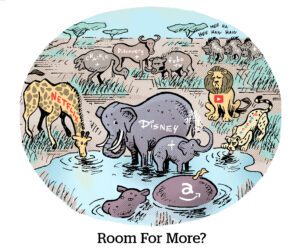Consumer health care company Haleon may be the first brand to use attention metrics to measure the quality of inventory bought through the Amazon DSP.
Haleon, which owns Advil, Tums, Sensodyne and Flonase nasal spray, has been experimenting with attention measurement alongside its agency Publicis for the past 18 months, said Phil Jackson, Haleon’s director of global digital marketing effectiveness innovation.
The goal is to prove that attention is not only a better measure of quality than proxies like viewability, but that attention also leads to better campaign performance. That’s the evidence brands would need to be comfortable basing their buying decisions on attention.
The results of Haleon’s recent test of Adelaide’s attention scoring solution within Amazon’s DSP – which saw higher ad recall and purchase intent for inventory with good vs. low attention scores – could strengthen the case that low-attention inventory isn’t worth buying.
Measurement methodology
Adelaide scores inventory using its proprietary attention unit (AU) metric by weighing data from real-world eye-tracking studies.
This data is fed into a machine learning model that estimates how likely an average user is to pay attention to a given ad placement, and it’s then combined with on-page signals, such as the amount of time someone hovers over a banner and whether they adjust the volume of a video ad.
Haleon’s test, which ran in mid-2023 during a campaign for Flonase targeting the US market, specifically measured the quality of display, video and streaming inventory sold through Amazon DSP.
Adelaide looked at placement-level reporting provided by Amazon DSP to correlate each placement’s performance with its attention score.
The decision to focus on Amazon sprang from a growing interest on Haleon’s part in retail media networks, Jackson said, which have a wealth of first-party consumer data that’s useful in correlating ad quality to outcomes.
Results
The attention measurement test was part of a wider post-campaign analysis by Cint (formerly known as Lucid).
According to Cint, CTV media with a high attention score drove a 37% lift in favorability, 19% higher ad recall and 9% higher purchase intent compared to inventory with low attention scores.
High-scoring retail media placements produced a 27% bump in “Detail Page Views,” which is the term Amazon uses to describe when people open a product listing featured in search results (either by clicking it or returning to a still-open tab later).
Meanwhile, high-attention display inventory led to conversions 34% more often than inventory with a low score. Cost per conversion on these high-attention placements was 25% lower.
For the purposes of this study, Haleon considered a high AU rating for CTV inventory to be a score of at least 60 out of 100. It set a slightly lower bar for display inventory, Jackson said, because people typically pay less attention to online banner ads.
For all media types, an AU of under 20 was considered low. Haleon is now seriously considering eliminating any ad inventory from future campaigns that falls below this threshold, Jackson said.
“We were able to quantify the amount of money that was currently being spent on media that was below those floors,” he said, “and there were double- or triple-digit thousands of dollars that could potentially be reinvested into placements that had a higher AU.”
Another tool in the toolbox
However, Haleon isn’t all-in on using attention scores as a buying parameter just yet, Jackson said.
Part of the reason is that DSPs have their own bidding algorithms and optimize toward different KPIs, which shouldn’t be discarded, Jackson said.
Attention-based buying can also lead to diminishing returns at the highest levels of attention. For example, the highest-scoring CTV inventory is scarce and often carries very high CPMs, so the performance boost provided isn’t always enough to justify the trade-off, according to Jackson.
Besides, attention measurement vendors are not currently integrated across all DSPs, he added.
And so Haleon remains in experimentation mode. It’s considering how to create high-attention private marketplaces, curated lists of preferred publishers and programmatic guaranteed deals, rather than applying attention measurement across all of its programmatic campaigns, Jackson said.
Haleon is also still playing the field. Other than Adelaide, Haleon works with Lumen and Amplified Intelligence, each of which has its own approach to measuring attention. For example, Adelaide considers more input data (like volume adjustments or cursor hover time) than Lumen or Amplified, which tend to focus more on panel data, Jackson said.
In other words, for now, attention measurement is just another tool in Haleon’s toolbox to assess media quality, and Jackson thinks attention vendors should lean into that framing rather than rushing to become a new buying standard like viewability.
“Ultimately, we need to prove [that] attention drives incremental business outcomes,” he said, “and we need to prove that achieving high attention is not going to be a massive disruption.”
(P.S. To address some of the elephants in the room: Haleon’s study predated Amazon introducing ads to Amazon Prime Video, and the campaign targeting did not rely on any of the data tied to Publicis Health’s recent $350 million settlement for its role in marketing opiates to doctors.)


















